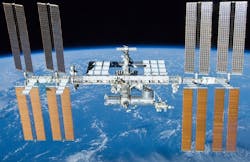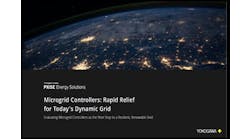From Naval Ships to Space Ships to Reliability Microgrids: The ERock Story
Sea, sky – and some sophisticated energy trading expertise – lies behind the reliability microgrids conceived by Enchanted Rock (ERock).
The Texas-based company made a splash last week with news that it has secured financing to install 50 MW of reliability microgrids for grocery stores and other commercial and industrial customers in Texas.
Marketed by subsidiary Texas Microgrid, the ERock microgrid differs from those often featured by the industry. No solar, no storage, not even combined heat and power, ERock’s microgrids use only reciprocating engine, natural gas generators.
Further, the company’s business model skirts the industry dilemma of monetizing reliability — the valuing and pricing of a microgrid’s ability to keep the lights on for customers when the central grid fails. ERock gives reliability away to customers at a low price, and instead makes its money by selling electricity and ancillary services to the central grid.
In space and at sea
The idea behind ERock’s technology and business model evolved slowly over several years.
Understanding the thinking behind the company’s product warrants a look at the background of its two founders, Thomas McAndrew and Clark Thompson.
Long before the term ‘microgrid’ was in common parlance, they were working on microgrid-like technology. They did so in environments where electric reliability could be a matter of life and death.
McAndrew is a nuclear engineer who worked on nuclear Naval ships — in essence floating microgrids. He also holds an MBA from Harvard, and later managed and led energy trading desks for major energy companies.
Meanwhile, Thompson, an aerospace engineer and now ERock’s chief technology officer, helped NASA develop key concepts for the Space Shuttle and International Space Station – also floating microgrids.
The partners’ keen focus on electric reliability, combined with McAndrew’s trading know-how, underlies the thinking behind ERock’s products.
The pair formed ERock in 2006. Two years later, after the devastation of Hurricane Ike, the company developed a model to own and operate distributed back-up generation for customers that can be optimized for the grid.
Read about ERock’s recent equity financing deal on Microgrid Knowledge.
ERock’s early projects used off-the-shelf diesel distributed generation, which serves such customers as the City of Houston, Coastal Water Authority, and various municipal utilities.
The company eventually developed proprietary natural gas generators and control algorithms for microgrids – which it defines as generation facilities that can operate in island mode or synchronously with the grid.
Reliability without barriers
To form microgrids, the company installs compact, modular gensets at customer sites. ERock guarantees that the gensets will supply automatic back-up power to the customer should an outage occur on the central grid.
“Their primary purpose it to provide reliability for our customers when the grid isn’t there. We are not there to replace the electric grid; we are there to augment it,” said McAndrew in an interview.
Customers pay a small one-time fee for installation of the on-site generators which ERock operates and maintains under 10 to 20-year contracts. The company declined to disclose exactly how much customers pay, but said it is a small percentage of what it would cost if they installed the microgrids themselves.
“We are able to subsidize for the customer the entry cost by using the power markets that are available. In this case we are using ERCOT. With the upfront contribution, plus the market returns, we are able to generate an attractive return for our investors,” said Robert Cauthen, ERock’s COO and president.
McAndrew added, “It’s a unique structure that we have been working on, quite honestly, for a long time. It makes it very, very economical for the customer to have a high level of reliability.”
From its 24-hour network operations center in Houston, ERock monitors and manages its fleet of microgrids and distributed generation. If there is a loss of power, ERock does not need to communicate with the microgrid; it automatically begins serving the customer.
Using its proprietary controller, ERock can aggregate gensets at a given customer location — or even several customer locations — into a virtual power plant. It then sells power and ancillary services from the virtual plant into ERCOT, Texas’ organized wholesale power market.
The business model creates no competition for utility or competitive suppliers, who may supply power to the customers. The customer solely buys reliability from the microgrid, not electricity for normal everyday use.
E-Rock sees a strong market for its grid services in Texas, where there is a great deal of wind power. The natural gas generators can quickly activate to serve the grid when the wind suddenly slows.
“On the ERCOT grid there is a large need for quick response assets. The market is very, very volatile,” McAndrew said.
Why no solar and batteries?
But why not add solar, storage and other advanced energy technologies that are becoming hallmarks of new microgrids? McAndrew said it’s a matter of keeping the cost of reliability low for the customer.
ERock wants to offer “reliability without barriers,” he said. “We’ve had situations here in Texas where we’ve been without power for weeks in certain areas after a hurricane. The amount of solar and storage you would need in many cases is much greater than the available real estate that a customer has, and it is incredibly expensive.”
He added: “Our job is to be there when the grid isn’t, and to do it in a way that is affordable and financeable. If I add a lot of capital costs to the microgrid, I’ll reduce the rate of return and not be able to finance it at a scale that matters.”
ERock sees a growing need for its service beyond just Texas. Within 12 months, the company expects to be looking at other markets in North America. It also sees global potential where there is aging grid infrastructure, a rise of renewables, or regions yet to be electrified.
“There is a lot of opportunity if you have the right technology and the right intellectual power and capital behind your company, and I believe we do,” said Cauthen.
Track news about emerging microgrid technology by subscribing to the free Microgrid Knowledge newsletter.







